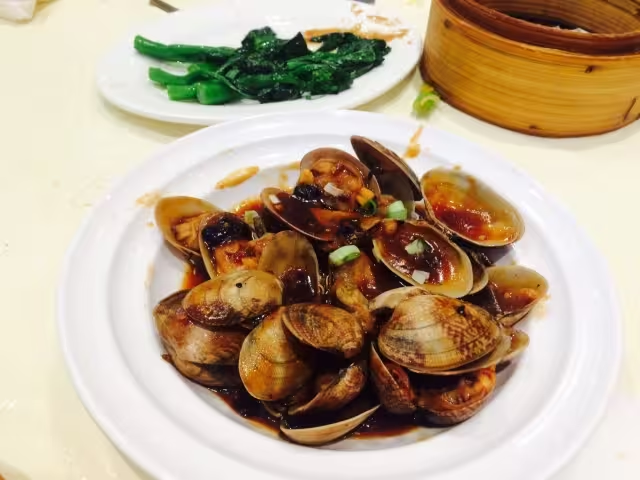Hamaguri clams hold a special place in Japanese culture, combining culinary appeal with deep symbolic meaning. Known for their sweet, delicate flavor, these clams are a cherished ingredient in traditional dishes, especially during celebrations like New Year’s and weddings. Read on to discover the fascinating history, cultural significance, and delicious ways this remarkable clam is celebrated in Japan.
What is Hamaguri?

When we think of the New Year and New Year’s celebrations, we think of osechi cuisine, ozoni, and clam soup in Kyoto. The clam-studded shellfish pattern also adds color to the New Year. In Japan, Hamaguri (蛤) refers to a type of hard clam, particularly the common orient clam (Meretrix lusoria). These clams are prized in Japanese cuisine for their sweet, delicate flavor and used in various traditional dishes. Hamaguri is not only appreciated for its taste but also carries symbolic meaning. Its perfectly matching shells are seen as a metaphor for harmony, unity, and fidelity, making it an auspicious food associated with celebrations, particularly weddings and New Year’s festivities.
Hamaguri History

In Japanese culture, clams are seen as a symbol of harmonious relationships and marital unity, making them a popular choice for New Year’s celebrations. According to Dining Guide by Motoyama Hagifune, a culinary researcher from the Meiji era, there is a noteworthy historical connection to clams from Muya, a region near the Yoshino River’s mouth along the Naruto Strait in Awa (now Tokushima Prefecture). Sei Shonagon, a prominent Heian-period court lady, spent her later years there. In the past, Muya’s clams were considered the standard and were carefully selected to be sent to Kyoto. This happened often on December 16, when clam fishing in the area officially began. These choice clams were then transported by the Nijo family to the Imperial Palace for official use.
In Kyoto, interactions between commoners, nobles, and samurai throughout history helped shape traditional annual events. This may explain the New Year custom of enjoying clam soup in Kyoto. Additionally, the Kamakura-era picture scroll Kasuga Gongen Genki portrays scenes of abalone and clams being ceremoniously brought into a mansion. With the shellfish meticulously piled and of uniform size, indicating the careful selection of only flawless clams for special occasions.
Auspicious meaning of Hamaguri in Osechi Ryori

In Osechi Ryori (Japanese New Year cuisine), Hamaguri clams hold special symbolic meaning. Due to their uniquely matching shells, Hamaguri clams represent harmony, marital fidelity, and good relationships. When two Hamaguri shells are placed together, they fit perfectly, symbolizing a harmonious and inseparable bond. These qualities are highly valued in relationships, especially within marriage. This auspicious meaning makes Hamaguri a cherished addition to Osechi Ryori, where foods are carefully chosen to bring good fortune, health, and happiness for the new year.
Methods of eating Hamaguri clams in Japan

- Sake Steamed
This method involves steaming clams with sake, which maximizes the clam’s umami flavor. The key is to remove them from the heat as soon as the shells open. - Grilled Clams
- Charcoal Grilled: This method involves grilling over charcoal or a grill, resulting in plump meat. Be careful not to spill the broth while grilling.
- Foil Grilled: Wrapping in aluminum foil and grilling is also easy and traps the umami flavor.
- Butter Soy Sauce Grilled
By adding butter and soy sauce to grilled clams, you can enjoy a rich flavor. It can be easily cooked in a toaster or on a hot plate. - Fried
This method involves coating raw clams with flour and breadcrumbs and frying them. The outside becomes crispy, while the inside remains juicy. - Risotto
Risotto made with clam broth becomes a dish concentrated with the clam’s umami. Simmering it with rice results in a flavorful dish. - Clear Soup
Clam-based clear soup is also used as a broth, offering a delicate taste to enjoy.
Game of Kai-awase using Hamaguri shell

The game of Kai-awase, played with clam shells, was a popular pastime among Heian-period aristocrats. In this game, players would try to find matching pairs based on the unique patterns on the inside of the clam shells. The game was more enjoyable when the shells were similar in size and pattern. This requires a collection of flawless, beautiful shells without any scratches. Observing the scene depicted in the Kasuga Gongen Genki scroll, it appears that the Imperial Palace had a plentiful supply of uniformly colored, patterned, and sized clam shells. Thus, inspired the development of Kai-awase as a refined game of elegance and aesthetic appreciation.
Final Thoughts

Hamaguri clams are more than just a delicious seafood choice in Japan; they carry rich cultural significance and symbolize harmony and unity in relationships. If you find yourself in Japan, don’t miss the opportunity to seek out these exquisite clams. Experience the delightful flavors and the meaningful connections they represent by trying Hamaguri for yourself.
You can try out other Osechi dishes we recommend below that will make you know more about Japan’s culture.
















Comments